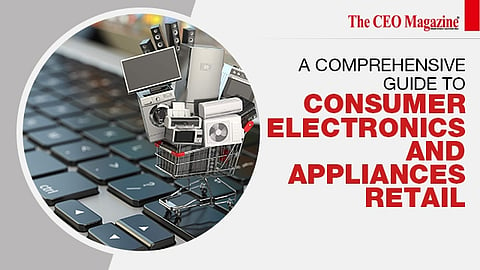

A Comprehensive Guide to Consumer Electronics and Appliances Retail
A Comprehensive Guide to Consumer Electronics and Appliances Retail
The consumer electronics and appliances retail industry is a fast-growing sector that has witnessed significant changes in the last few years.
From brick-and-mortar stores to online marketplaces, retailers have been adapting to the changing landscape of consumer preferences and technological advancements.
This article will provide a comprehensive guide to the consumer electronics and appliances retail industry, exploring the different types of products, the latest trends, and the challenges faced by retailers in this space.
Consumer electronics and appliances refer to a wide range of products that are designed for personal or household use.
These products can be classified into different categories based on their functionality and purpose. Here are some of the most common types of products sold in consumer electronics and appliances retail:
Home Appliances - These include refrigerators, washing machines, dishwashers, air conditioners, and other appliances that are designed for household use.
Consumer Electronics - These include televisions, home theatre systems, cameras, laptops, smartphones, and other electronic devices that are designed for personal use.
Gaming Consoles - These include consoles such as PlayStation, Xbox, and Nintendo, along with associated games and accessories.
Wearable Devices - These include smartwatches, fitness trackers, and other devices that are worn on the body.
Personal Care Products - These include hair dryers, electric shavers, and other personal grooming devices.
The consumer electronics and appliances retail industry is a constantly evolving space that is shaped by changing consumer preferences and technological advancements. Here are some of the latest trends that are shaping the industry:
Online Marketplaces - With the rise of e-commerce, online marketplaces have become an increasingly popular way for consumers to purchase consumer electronics and appliances. Retailers are investing in their online presence to reach a wider audience and offer a more convenient shopping experience.
Smart Homes - As technology advances, smart homes are becoming more common. Consumers are looking for appliances and devices that can be connected to their home network and controlled using their smartphones or other devices.
Sustainability - Consumers are becoming more conscious about the impact of their purchases on the environment. Retailers are responding by offering more eco-friendly products and reducing their carbon footprint.
The consumer electronics and appliances retail industry is a highly competitive space that is constantly evolving. Retailers face several challenges as they try to keep up with the latest trends and meet the changing demands of consumers.
Some of the challenges faced by retailers in this space include:
Price Competition - Consumers are increasingly price-sensitive and have access to a wide range of retailers offering competitive prices. Retailers need to offer attractive prices while maintaining a reasonable profit margin.
Changing Technology - Technology is constantly evolving, and retailers need to stay up-to-date with the latest trends to remain relevant. This requires significant investments in research and development, as well as training for employees.
Logistics and Delivery - As consumers increasingly purchase products online, retailers need to offer efficient and reliable delivery options. This requires investment in logistics and delivery infrastructure.
The consumer electronics and appliances retail industry is a dynamic and constantly evolving space that is shaped by changing consumer preferences and technological advancements.
Retailers need to be aware of the latest trends and challenges facing the industry to remain competitive and meet the changing demands of consumers.
By investing in their online presence, offering eco-friendly products, and staying up-to-date with the latest technology, retailers can thrive in this fast-growing industry.
Follow us on Google News
